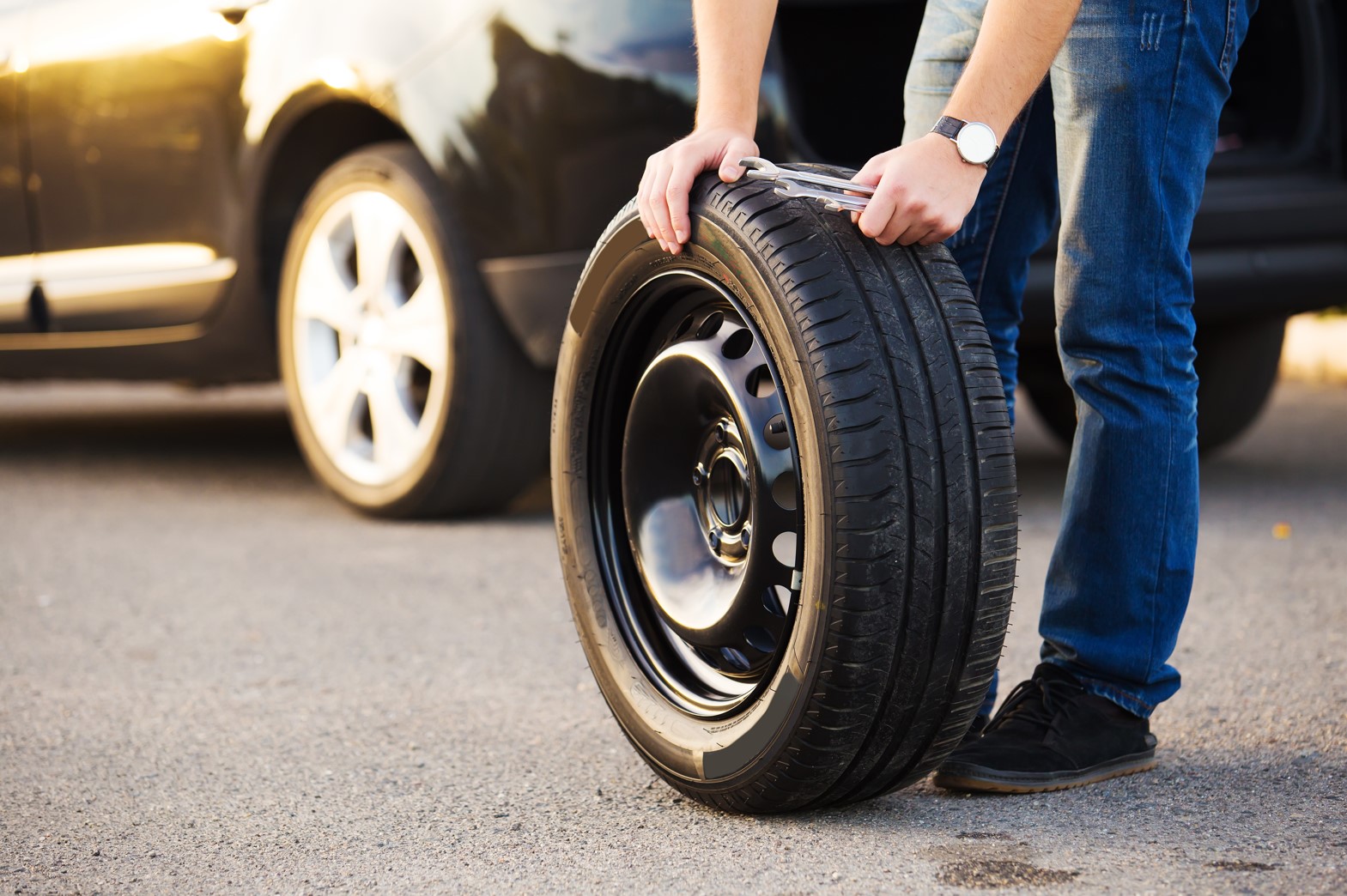What is the maximum distance you can travel on a spare tire? The answer depends on the type of spare tire you have, but generally, you should only drive on a spare for a short distance and at a reduced speed. This article will explore the spare tire distance, temporary tire range, donut tire mileage, space saver tire limit, spare tire travel limitations, emergency tire lifespan, how long can you drive on a spare, spare tire speed restrictions, compact spare tire distance, and maximum distance on spare tire. By the end, you’ll understand the limitations of your spare and how to avoid getting stranded.

Image Source: www.cbac.com
Different Types of Spare Tires
Not all spare tires are created equal. Knowing what type you have is the first step in comprehending its limitations.
Full-Size Spare Tire
- Resembles your regular tires.
- Can be used for longer distances.
- May not match your other tires exactly (check tread depth and tire type).
- Less common in newer vehicles.
Temporary or “Donut” Spare Tire
- Smaller and lighter than regular tires.
- Distinctive appearance.
- Designed for short-term use only.
- Most common type of spare.
Folding Spare Tire
- Inflated with an air compressor.
- Saves space when deflated.
- Can be more challenging to inflate properly.
Run-Flat Tires
- Reinforced sidewalls.
- Allows you to drive for a limited distance after a puncture.
- Not technically a spare tire, but serves a similar function.
The Critical Question: How Far Can You Really Go?
The spare tire distance varies widely depending on the kind of spare you have. Each type has specific spare tire travel limitations you must know.
Temporary Spare (“Donut”): The Limited Runner
- Maximum Distance on Spare Tire: Typically, manufacturers recommend a donut tire mileage of no more than 50-70 miles.
- Spare Tire Speed Restrictions: Usually, a maximum speed of 50 mph (80 km/h) is advised.
- Reasoning: Donut spares are designed for emergency tire lifespan only. They offer reduced traction and stability. Driving beyond the compact spare tire distance can compromise safety.
- What happens if you ignore these limits? The tire could fail, leading to a loss of control and potential accidents.
Full-Size Spare: A Longer Journey, Maybe
- If it’s an exact match to your regular tires: You could drive indefinitely, but it’s still best to get the damaged tire repaired or replaced as soon as possible.
- If it’s a different tire (different brand, slightly different size, different tread depth): Treat it as a temporary spare. Drive no more than a few hundred miles and at a reduced speed (no more than 65 mph).
- Why the caution? A mismatched tire can affect your vehicle’s handling, especially in adverse weather conditions. It can also put extra strain on your vehicle’s drivetrain.
Run-Flat Tires: A Grace Period
- Temporary Tire Range: Run-flat tires typically allow you to drive for up to 50 miles at speeds no higher than 50 mph after a puncture.
- Warning System: Your car must have a tire pressure monitoring system (TPMS) to alert you of the pressure loss.
Why These Limitations?
Several factors contribute to the spare tire travel limitations and emergency tire lifespan.
Size and Construction
- Temporary spares are smaller and lighter, affecting handling and braking.
- They have less tread, reducing traction, especially in wet or snowy conditions.
- The materials used are often less durable than those in regular tires.
Heat Buildup
- Driving at high speeds or for long distances on a temporary spare can cause excessive heat buildup.
- This can lead to tire failure, including blowouts.
Stress on Vehicle Systems
- Mismatched tires can strain your vehicle’s differential, anti-lock braking system (ABS), and traction control system.
- This can lead to premature wear and costly repairs.
Factors Affecting Spare Tire Longevity
Several factors influence how long can you drive on a spare.
Load
- Overloading your vehicle puts extra stress on the spare tire.
- Reduce your speed and distance accordingly.
Road Conditions
- Rough roads and potholes can damage the spare tire more quickly.
- Avoid driving on unpaved roads if possible.
Weather Conditions
- Extreme temperatures can affect tire pressure and performance.
- Wet or icy conditions reduce traction, increasing the risk of skidding.
Driving Style
- Aggressive driving (hard acceleration, braking, and cornering) puts extra stress on the spare tire.
- Drive smoothly and cautiously.
Safety Precautions When Using a Spare Tire
Safety is paramount when driving with a spare. Adhere to these guidelines:
- Check Tire Pressure: Ensure the spare is inflated to the correct pressure (usually higher than your regular tires – check the sticker on the spare tire itself).
- Tighten Lug Nuts: After changing the tire, double-check that the lug nuts are properly tightened. Use a torque wrench if possible.
- Drive Slowly: Stick to the recommended spare tire speed restrictions.
- Avoid Harsh Maneuvers: Accelerate, brake, and turn gently.
- Monitor Tire: Frequently check the spare for any signs of damage or wear.
- Get it Fixed ASAP: Replace the spare with a regular tire as soon as possible.
Practical Tips to Avoid Getting Stranded
Planning and preparation can reduce the likelihood of needing to rely on your spare.
Regular Tire Maintenance
- Check your tire pressure monthly.
- Rotate your tires every 5,000-7,000 miles.
- Inspect your tires for wear and damage regularly.
- Replace worn tires promptly.
Emergency Roadside Kit
- Include a spare tire (in good condition), jack, lug wrench, flashlight, jumper cables, and a first-aid kit.
- Consider adding a tire inflator and sealant.
Roadside Assistance
- Enroll in a roadside assistance program (AAA, etc.).
- Keep the contact information handy.
Driving Habits
- Avoid driving over potholes and debris.
- Drive defensively.
- Be aware of road conditions.
Replacing Your Damaged Tire
Promptly replacing the damaged tire is crucial for safety and vehicle performance.
Tire Repair
- Punctures in the tread area can often be repaired by a professional.
- Sidewall damage usually requires tire replacement.
- Ensure the repair meets industry standards.
Tire Replacement
- Replace tires in pairs (or all four) to maintain even wear and handling.
- Choose tires that match your vehicle’s specifications.
- Consider all-season tires for versatility.
The Downsides of Ignoring Spare Tire Limitations
Disregarding the spare tire travel limitations has serious consequences:
- Tire Failure: Blowouts can cause loss of control and accidents.
- Vehicle Damage: Strain on drivetrain and other systems.
- Safety Risk: Reduced handling and braking capabilities.
- Inconvenience: Getting stranded again.
Table: Spare Tire Comparison
| Feature | Full-Size Spare (Matching) | Full-Size Spare (Non-Matching) | Temporary Spare (Donut) | Run-Flat Tires |
|---|---|---|---|---|
| Distance Limit | Unlimited (but replace ASAP) | A few hundred miles | 50-70 miles | Up to 50 miles |
| Speed Limit | Normal driving speed | 65 mph (105 km/h) | 50 mph (80 km/h) | 50 mph (80 km/h) |
| Handling | Normal | Slightly compromised | Significantly compromised | Slightly compromised |
| Durability | High | Medium | Low | High |
| Commonality | Less common | Less common | Very common | Varies by vehicle |
Case Studies
- Case 1: The Cross-Country Traveler: A driver ignores the donut’s limitations and attempts a 300-mile trip. The tire fails halfway, causing significant damage to the vehicle’s suspension.
- Case 2: The City Commuter: A driver uses a donut spare for several weeks while delaying a tire replacement. The spare tire’s reduced traction leads to a minor collision in wet conditions.
Fathoming the Future of Spare Tires
The future may bring changes to how we handle flat tires.
- Tire Technology: Self-sealing tires and improved run-flat technology may reduce the need for spares.
- Mobility Services: Increased availability of roadside assistance and mobile tire repair services.
- Vehicle Design: Some manufacturers are eliminating spare tires altogether to save weight and space, relying on the aforementioned alternatives.
Frequently Asked Questions (FAQ)
- Can I drive on a spare tire in the rain? Yes, but reduce your speed and drive cautiously. Temporary spares have significantly less traction than regular tires, making them more prone to hydroplaning.
- What is the proper tire pressure for a spare tire? Check the sidewall of the spare tire itself. The pressure is usually higher than your regular tires.
- How do I know if my car has run-flat tires? Look for the “Run Flat” designation on the tire sidewall. Your vehicle will also have a Tire Pressure Monitoring System (TPMS).
- What happens if I drive over the speed limit on a spare tire? You increase the risk of tire failure, loss of control, and accidents. Adhere to the recommended speed.
- Can I repair a temporary spare tire? No, temporary spare tires are not designed to be repaired. They must be replaced if damaged.
- Is it safe to drive with a spare tire in winter conditions? It is not recommended. Reduced traction and stability are major concerns. If you must, drive extremely cautiously and at very low speeds.
- How often should I check my spare tire? At least every month, along with your regular tires. Ensure it is properly inflated and free from damage.
- Are full-size spares always identical to my other tires? Not always. Sometimes, it’s a different brand or a slightly different size. Treat non-matching full-size spares as temporary spares.
- What if I don’t have a spare tire? Many newer cars come with tire inflation kits or rely on run-flat tires. If you have an inflation kit, follow the instructions carefully.
- Does driving on a spare affect my car’s warranty? Generally, no, as long as you follow the manufacturer’s recommendations for spare tire usage. However, prolonged use of a mismatched spare could potentially affect the drivetrain warranty. Check your warranty details.
By following these guidelines, you can minimize the risk of getting stranded and ensure your safety when using a spare tire. Remember, a spare is a temporary solution, not a permanent replacement.

Hi, I’m Candace Wafford, a travel and food blogger based in Lexington, Kentucky. As a corporate traveler, I’ve had the chance to explore a lot of places, but now I’m on a mission to travel full-time. My goal? To figure out how to take my cat along for the adventure! Here at destinationdorworth.com, I share my experiences and tips on outdoor activities, travel, and of course, the best food spots I come across. I hope my blog inspires you to explore more and eat well on your journeys!
